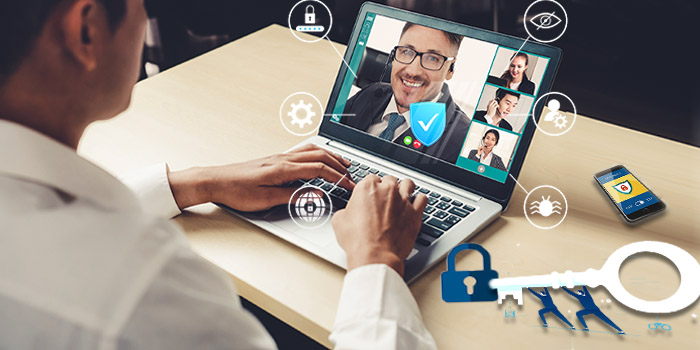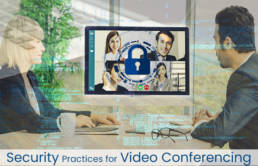The coronavirus pandemic has caused the most significant shift towards remote working that the world has ever witnessed.
In a bid to ensure business continuity during the ongoing crisis, almost all companies are striving to leverage robust and convenient online communication tools that facilitate remote work and learning.
Technology in the form of video conferencing, voice calls and group chat became the need of the hour.
Not only the businesses, but even educational institutes are also using these tools to ensure that the learning continues.
The demand for collaboration platforms such as Microsoft Teams, Zoom, GoToMeeting, Skype, and Slack skyrocketed undeniably.
Microsoft Teams now has witnessed more than 44 million daily users, up by 12 million within a week.
Other collaboration platform Zoom Meetings has become the most downloaded app with daily users more than 300% from before pandemic.
However, this has created security challenges for many organizations as they often lack the required experience and technologies to mobilize a remote workforce in a secure manner.
According to a survey of 500 decision-makers across several industries, 80% believe that cloud collaboration tools are very vulnerable to cyberattacks.
As per Check Point Research, 1,700 new “Zoom” domains registered since the beginning of 2020. From these, 70 domains found to be suspicious.
Meanwhile, Morphisec Lab researchers found a flaw in the Zoom App that can enable cybercriminals to voluntarily record Zoom sessions and capture chat text without the knowledge of any of the meeting participants.
So, organizations must manage the privacy and security of their online meetings. At this juncture, we bring you some best practices for hosting secure online meetings.
6 Best Practices To Secure Online Meetings

1) Enable Password Protection
Setting a password is the first thing you should do to secure your virtual meetings. Make passwords mandatory for all your online meetings to prevent unwelcome attendees from joining the session. The participants will need to enter the secret password set by you to join the meeting.
While you can share the password with the participants through the meeting link, sharing it verbally or in a separate email or message can enhance the security.
2) Check Participants
Ensure to recheck the participants before sending the meeting invitation. Remove anyone from the list who is not supposed to be part of the meeting.
During the meeting where confidential information is being shared, enhance security by mandating participants to authenticate by signing in before joining the meeting.
3) Keeping Tabs on Meeting Links
Cybercriminals are using malicious links disguised as authentic vendors to gain access to your network. So, before clicking on the meeting invitation, check whether it’s from a known, trusted vendor.
4) Manage Access to Shared Content
With the built-in customization controls in the video conferencing platforms, you can choose to let anyone or specific participant access the content shared in the meeting.
By managing the access controls, you can prevent malicious activities by restricting access for content sharing, video sharing and chat only to invited participants.
5) Mobilize a Video Conferencing Policy
Owing to the rise in cyberattacks targeting online meetings, it’s highly recommended to have a video conferencing policy at your disposal. With a video conferencing policy, you can set clear boundaries and expectations for users.
You can outline user permissions for both in-house and remote participants for conducting video conferences.
6) Adopt Domain-based Security
The video conferencing providers who take a domain-based approach to security can witness online collaboration in a secure and well-controlled environment. Domain-based security enables the concerned authorities to control access to video conferences by assigning various levels of permission to users.
With the domain-based security, an outsider attempting to start an online meeting with someone within your company should wait until a user with the required permissions signs on and grants the access.
In Conclusion
Apart from implementing the aforementioned security practices, try to bring awareness to the remote workforce about the everchanging security landscape to ensure the safe and secure use of video conferencing technologies.
Ensure that your video conferences are equipped with best-in-class security and video technology to increase employee collaboration and productivity while reducing technology vulnerabilities.
Still Struggling to Host a Secure Online Collaboration? Stealthlabs is here to help.
How Can Stealthlabs Help?
StealthLabs is a US-based IT Security Services and Solutions provider with strong domain expertise in securing a remote team and online meetings.
More Cybersecurity Articles:
- Steps to Create An Information Security Program Plan
- Telemedicine and Cybersecurity: Securing Health Data!
- Infographic – Cybersecurity Myths Vs Reality
- Cybersecurity Myths and Misconceptions Worth Knowing!
- Data Privacy Vs. Data Security: What is the Core Difference?
- Infographic: Tips To Prevent Ransomware Attacks!
- 4 Ways MSSPs Can Improve Their Security Offering Through Automation
- Top 8 Mobile Cybersecurity Threats You Should Know to Protect Your Data!

